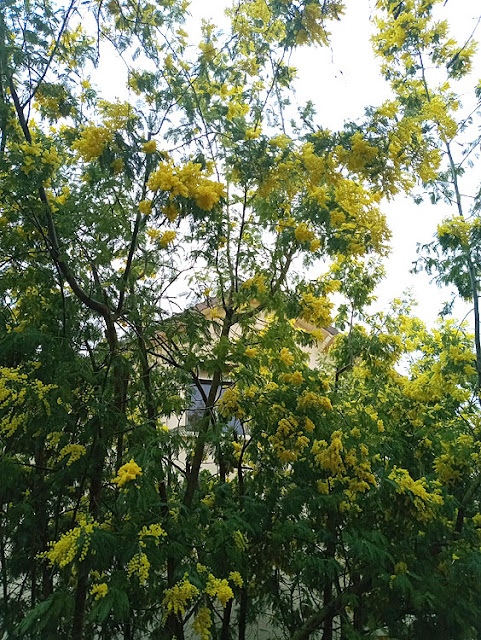On the eve of International Womens Rights Day my friend André emailed with a series of photos of his gorgeous Silver Wattle Acacia dealbata (mimosa to him) flowering away like crazy. His note said to come over and fetch some whenever you like. So I did.
He knew 'mimosa' was Australian, and that Nicolas Baudin's expedition had brought it back for the Jardin des Plantes (the national botanical gardens in the middle of Paris), and perhaps more significantly, for the Empress Josephine to plant at Malmaison. It thrived there and she sent plants to the south of France where it has now unfortunately naturalised and become an invasive alien species.
Mimosa is beloved in France because of the time it flowers, in early March, and even earlier in the south. In March most European trees don't have their new leaves, and most haven't flowered yet.
What he didn't know though was the charming tradition of men giving women mimosa on International Women's Day in European countries from Russia to Italy. I think the idea is that you get a sprig like a button hole, but André got a bit carried away. I came home with a car boot full of mimosa (I'm not kidding!). It was so much that I couldn't find enough space for it in the house and so I gave some of it away to various friends.
André's Silver Wattle is thriving, and he says it gets better every year. It looks like it has been pollarded or suckers readily as it is really a thicket of wattle by one end of his house. None of the stems are very thick.





7 comments:
There are invasive plants worse than that. I remember walking in the Tanneron Hills between Grasse and Cannes and been almost overwhelmed by the sent of thousands of “mimosas” in February. Not only the delicious sent but the beautiful yellow light given off by all these blooming trees is one thing to remember.
I see that your friend uses an échenilloir to cut the flowers up high.
I didn’t know “our” mimosa could grow and bloom inland as far North as the Loire Valley.
I don’t know why M. Robin thought that the American Black Locust was a “pseudo” acacia. Anyway, the name stuck and that’s what we call it in French. It doesn’t look like the Australian acacia that we call mimosa. Confused?
chm: I think A. dealbata will more or less grow anywhere in France. And it gets even more confusing when you consider that real mimosa is a third species, nothing to do with Acacia or Pseudoacacia.
RE : Acacia—I just read the Wikipedia page for Vachellia nilotica and I’m more confused than ever! LOL!
chm: Wow! That article needs a rewrite by someone less bitter and twisted!! The Australian argument was that there are hundreds more species of Acacia in Australia than anywhere else, and to have to reclassify the Australian species would cost thousands in terms of hours, labour and money. All the museum and herbarium specimens would need to be relabelled, all the text books and field guides reprinted. They asked to be a special case and keep the name Acacia for the Australian species, thereby meaning that the African species had to be renamed.
In my former village of Roquebrun there is a Fete du Mimosa toward the end of February, it is a microclimate and the mimosa are blooming then, earlier than anywhere else nearby. It attracts thousands of visitors, with a parade, artisan works for sale, a lunch, etc. Sadly I am allergic to mimosa flowers .... I find it too invasive anyway. Robinia pseudoacacia is also invasive, both in its native US and here in France.
bonnie in carpentras
bonnie: Many people are allergic to it, and it is certainly a strong scent.
Post a Comment